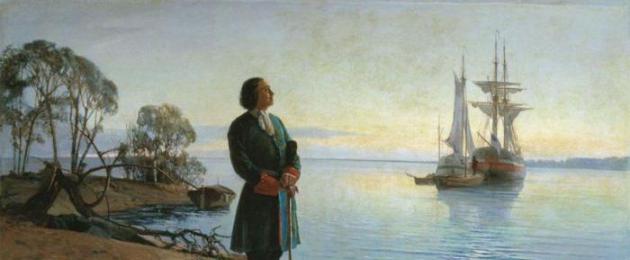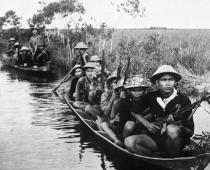Since the 16th century, Muscovite Russia, in a constant struggle with the Crimean and Nogai Tatars, tried to seize the coastal zones of the Azov and Black Seas. Numerous wars with the Ottoman Empire until the end of the 17th century did not lead to definite results. And only with the ascension to the throne of Peter I, a decisive step was taken on the way to access to the southern seas, as well as to the creation of the Russian fleet - the capture of the Turkish fortress of Azov. These events, called the Azov campaigns, were the first significant achievements of the young autocrat.
Personality of Peter I
The presence of strong personal qualities, will, worldview, first of all, Peter is obliged to Mother Nature, who endowed him with a lively, receptive to science mind and many talents. Peter was left without a father at the age of 4, and at the age of 10 - without a brother. All adolescence and youth, he was left to himself, his education was neglected, no one was engaged in the education of the future sovereign. Those years when the main qualities are formed in a person, he spent in some way in disgrace, in the village of Preobrazhensky, with his mother. Natalya Kirillovna, due to her female perception, could not give her son the education that was necessary for his high appointment. However, Peter himself found an example to follow - Lefort from Geneva, who settled in the German Quarter near Moscow and immediately gained authority from the young tsar.
Subsequently, together with Peter Lefort, he went on the Azov campaigns, personally captured the Turkish banner, and was soon appointed admiral of the Russian fleet. From this smart, educated military boy-king, he first heard about Europe, famous generals, navigation, and he himself set on fire with the idea of starting a new type of army and fleet.
Russian-Turkish conflicts

Since the conquest of the Crimea by Turkey in 1475, Russian-Turkish relations have remained quite tense for several centuries.
In the second half of the 17th century, Turkey, in addition to conquering Podolia from the Commonwealth, from Venice - the island of Crete, tried to take possession of the Right-Bank Ukraine. This was met with opposition, and as a result of the Chigirin campaigns (1677, 1681), Russian and Ukrainian Cossack troops completely thwarted the capture attempts.
As a result, an armistice agreement was signed between Russia, Turkey and the Crimean Khanate in Bakhchisarai (Bakhchisarai peace treaty, 1681). It was of great international importance.
However, the terms of the Bakhchisaray agreement were annulled when the "Eternal Peace" was signed with Poland, which ended the Russian-Polish war, but obliged the Russian kingdom to resume military campaigns against the Crimean Khanate.
In 1687 and 1689, under the command of the favorite of Queen Sophia, Prince V. Golitsyn, two campaigns were undertaken against the Crimea and Turkey, which did not bring success. Then it was obvious that Russia did not have enough potential to win.
Preparation for the Azov campaigns
Adolescence passion for military affairs led to the creation by Peter in the village of Preobrazhensky amusing company, where his peers enrolled. Over time, their number increased so much that some of them were transferred to Semenovskoye. It was from them that two regiments were subsequently formed - Semenovsky and Preobrazhensky, where military affairs were studied according to all the rules of European military science. This was the beginning of the Russian guard.

Having come to autocracy, Peter does not give up adolescent games, they gradually acquire an increasingly serious strategic character. But the young king is still obsessed with the sea. At his whim, the construction of ships in Arkhangelsk begins.
In 1693, he personally visited Arkhangelsk, the only seaport at that time, and clearly realized that the White Sea alone was not enough for the development of foreign policy and the economy. Indeed, Russia still does not have access to the non-freezing maritime space. There is an urgent need for access to the Black Sea waters, where the Ottoman Empire reigns. Back in the early 1990s, Poland and Austria, Russia's allies, concluded amicable agreements with Turkey, which in no way met the interests of the Russian lands. Peter I himself enters into negotiations with the Crimean Khan and puts forward demands for free movement in the southern seas, an end to raids and payment of tribute. Negotiations by the Tatars were disputed for a long time and dragged on.
Then Peter begins preparations for a new war with Turkey. This makes it necessary to conduct serious exercises in the autumn of 1694 in the village of Kozhukhovo near Moscow, which last 3 weeks. The main task of the maneuvers is to cross the Moscow River and capture the fortress, specially built for this. Petrovsky regiments are victorious over the traditional archers. After that, the king makes a firm decision next year to go on a campaign and initially strike at the fortress of Azov, which is located at the mouth of the Don.
First Azov campaign
![]()
Preparations took the winter and spring of 1695, when efforts were made to build the first flotilla. On the Don, sea boats and plows were built, as well as rafts for the delivery of troops, ammunition, and provisions.
In the spring, 3 groups of troops under the command of Gordon, Lefort, Golovin began to move south along the Volga and Don regions. Part of the army under the command of Sheremetyev went to the lower reaches of the Dnieper, where Ukrainian Cossacks joined it. In fact, Peter led all the actions, but at the same time he acted as a scorer. During the 1st Azov campaign, the tsar himself filled shells and fired.
The Turks managed to capture two small fortresses, but the main goal - the fortress of Azov, surrounded by ramparts and ditches, was still inaccessible. In June, Peter's troops began the siege of Azov. But the besieged received help from the sea. The Russian army was not ready to operate far from supply bases.
Great damage was done by the Dutchman Jacob Jansen - a foreigner, an engineer, favored by the king. He knew Peter's plans and, going over to the side of the enemy, betrayed the Russians to the Turks. As a result, the Janissaries attacked from the weak side of the Russian army. However, General Gordon arrived in time to help and beat them off. This clash further weakened the Russian army.
The assault attempts made on August 5 and September 25 were unsuccessful. In October, Peter I gives the order to lift the siege.
Russian victory

1 The Azov campaign was not crowned with success. But this not only did not plunge Peter into despondency, but, on the contrary, greatly provoked him. Already in the winter of 1695, Peter began preparations for a new campaign. Now all the forces were sent to Voronezh, to create a rowing Russian flotilla. Within a few months, various ships were built, led by the 36-gun ship Apostol Peter.
Already in May 1696, the 40,000th Russian army began the Second Azov campaign. Don and Zaporozhye Cossacks actively joined it. Generalissimo Shein commanded military operations. Now Russian ships from the sea blocked the fortress. Peter I, along with everyone else, with the rank of captain, took part in the siege.
On July 19, the fortress of Azov capitulated, and for the first time Russia opened access to the southern seas. During the 2nd Azov campaign, the Russian army obtained 16 Turkish banners, 130 guns.
This was the first significant success of the 24-year-old king in foreign policy. As a sign of consolidating success, Peter gives the order to build a fortress and a harbor on Cape Taganrog.
The historical significance of the Azov campaigns of Peter I
This is how Tsar Peter the Great began his state and military career. The Azov campaigns brought him not only fame and prestige, but also experience. It was then that he realized that for new achievements and gaining authority, Russia needed a strong fleet. Already on October 20, 1696, a meeting of the Boyar Duma made a decision to expand shipbuilding. This day is considered the birthday of the Russian fleet.
The Azov campaigns, the results of which influenced the development of the fleet and military affairs in Russia, became the starting point for the further activities of Peter I to strengthen the country's defense capability.
The results of the capture of the fortress
The Azov campaigns of Peter 1 are a very important step for Russia on the way to the Black Sea, to the further advancement of the state to the south. As a result of these campaigns, the following goals were achieved:
- the capture of the Azov fortress was carried out;
- the first exit of the Russian fleet to the southern seas;
- an attack from the sea became possible;
- the port of Taganrog began to be built;
- the southern borders of Russia became secure;
- the prerequisites for the creation of a professional fleet arose.
In 1699, a Russian ambassador arrived in Constantinople on the 46-gun Russian ship Fortress to negotiate peace. The Sultan was struck by the greatness of the ship and in July 1700 made peace, leaving the fortress of Azov to Russia.
Consolidation of positions

Peter well understood that in order for Azov to remain in tsarist Russia, it was not enough just to conquer it. It was necessary to make it a Russian city. To do this, the king moved 3,000 families there, put a cavalry detachment of 400 soldiers and 3,000 infantry in the city to keep order.
Azov was strengthened, mosques were transformed into churches, merchants, townspeople, and artisans moved to the Sea of \u200b\u200bAzov. As the Russian population grew, customs changed. There is evidence in the historical archive that Peter, having visited Azov some time later, was in a very good mood, hearing Russian speech at every corner.
Azov - starting point

Azov was captured and finally assigned to Russia. Now this milestone passed no longer seemed to Peter so important. He had far-reaching plans. The Azov campaigns of Peter 1 became the starting point in the most important business - the mastery of the Black Sea.
The possession of Azov did not satisfy the tsar, it was perceived by him only as a point that opened the way for the further movement of Russia to the south.
Already on November 4, 1696, Peter I in the Preobrazhensky village gathered a Duma of Russian boyars and close foreigners, where the issue of creating a fleet for a new military campaign in the shortest possible time was decided and a strategy was developed to suppress stubborn opposition from the Turks and Tatars. A new page was opened in the history of Russia.
- In contact with 0
- Google+ 0
- OK 0
- Facebook 0








